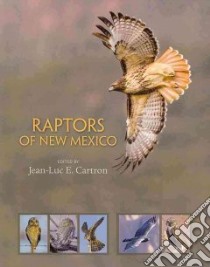Raptors of New Mexico - 9780826341457
Un libro in lingua di Jean Cartron luc E. (EDT) edito da Univ of New Mexico Pr, 2010
- € 39.40
- Il prezzo è variabile in funzione del cambio della valuta d’origine
No Book has Ever Before Specifically Focused on the Birds of prey of New Mexico. Both Florence Bailey (1928) and J. Stokley Ligon (1961) published volumes on the birds of New Mexico, but their coverage of raptors was somewhat limited. In the ensuing years a great deal of new information has been collected on these mighty hunters' distribution, ecology, and conservation, including in New Mexico.
The book begins with a history of the word "raptor." The order of Raptatores, or Raptores, was first used to classify birds of prey in the early 19th century, derived from the Latin word raptor, one who seizes by force. The text then includes the writings of forty-one contributing authors who relate their observations on these regal species.
"From spring to fall each year at the Jornada Caves in the Jornada del Muerto, Swainson's Hawks assemble daily to catch bats. The bats exit the caves---actually lava tubes---near sundown. The hawks swoop in, snatch bats from the air, and eat them on the wing."
Originally from France, Jean-Luc Cartron has lived and worked on several continents, finding his passion in the wide-open spaces of New Mexico. He became fascinated by the birds of prey and has studied their ecology and conservation for nearly twenty years.
Raptors of New Mexico will provide readers with a comprehensive treatment of all hawks, eagles, kites, vultures, falcons, and owls breeding or wintering in New Mexico, or simply migrating through the state. This landmark study is also beautifully illustrated with more than seven hundred photographs, including the work of more than one hundred photographers, and nearly fifty species distribution maps.
"Few Places on Earth Remain untouched by the activities of humans. Among all species---many of which are declining rapidly toward extinction---raptors are at least fortunate enough to be regarded as ecologically important, charismatic, or simply enriching of people's lives. In much of North America, birds of prey are doing far better today than they were in the early and mid 20th century, when shooting and pesticides caused many raptor populations to plummet. And yet, in New Mexico as elsewhere, only our commitment to protect natural lands will ensure that our grandchildren and great grandchildren grow up to the familiar hoot of an owl and to the sight of the soaring hawk or the diving falcon."---From the Conclusion
Informazioni bibliografiche
- Titolo del Libro in lingua: Raptors of New Mexico
- Lingua: English
- Autori : Jean Cartron luc E. (EDT)
- Editore: Univ of New Mexico Pr
- Collana: Univ of New Mexico Pr (Hardcover)
- Data di Pubblicazione: 31 Maggio '10
- Genere: NATURE
- Argomenti : Birds of prey New Mexico Birds of prey New Mexico Identification
- Pagine: 710
- ISBN-10: 0826341454
- EAN-13: 9780826341457


